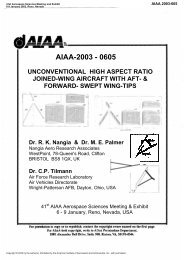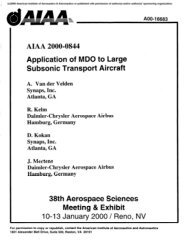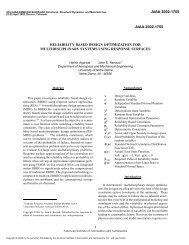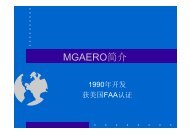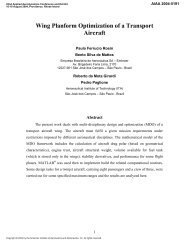RCS analysis and reduction for lossy dihedral corner ... - IEEE Xplore
RCS analysis and reduction for lossy dihedral corner ... - IEEE Xplore
RCS analysis and reduction for lossy dihedral corner ... - IEEE Xplore
Create successful ePaper yourself
Turn your PDF publications into a flip-book with our unique Google optimized e-Paper software.
then numerically integrating the current densities. If the<br />
common geometrical optics (image) approximation was<br />
made at the first reflection, less accurate results would be<br />
obtained [9]. The UTD is seen to compare better with the<br />
experimental results, <strong>and</strong> the physical optics is less accu-<br />
rate. The acute angled <strong>corner</strong> shows the largest differences,<br />
<strong>and</strong> the physical optics results would generally improve <strong>for</strong><br />
right <strong>and</strong> obtuse <strong>corner</strong>s. A <strong>lossy</strong> <strong>corner</strong> reflector pattern,<br />
corresponding to 1) = 0.2, is also shown to indicate reduc-<br />
tions that can be achieved due to the <strong>lossy</strong> nature of the<br />
surfaces.<br />
IV. CONCLUSIONS<br />
The <strong>corner</strong> reflector is a very important geometry to study<br />
because it demonstrates many of the scattering properties<br />
of more complex targets. Hence it is possible to infer the<br />
scattering characteristics of other geometries from the<br />
characteristics of the <strong>corner</strong> reflector. The UTD is especially<br />
useful <strong>for</strong> this purpose because it isolates individual scat-<br />
tering mechanisms, <strong>and</strong>, in contrast to the moment method,<br />
it allows the dominant terms to be identified. In this work,<br />
it was shown that the UTD is also accurate in that it com-<br />
pares well with moment method techniques <strong>for</strong> coated cor-<br />
ner reflectors which may have right, acute, or obtuse inte-<br />
rior angles.<br />
To achieve good cross-section <strong>reduction</strong>, it was dem-<br />
onstrated that one must select an appropriate wedge angle<br />
as well as a good surface coating material. For more com-<br />
plicated geometries, this implies that the specular reflec-<br />
tions should be eliminated when possible, especially by<br />
avoiding right-angled <strong>corner</strong>s. Obtuse angles are pre-<br />
ferred because they divert the strong double-reflected wave<br />
awayfrom the backscatter direction without inducing more<br />
multiple reflections. Acute <strong>corner</strong>s develop larger multiple<br />
reflections <strong>and</strong> diffractions which tend to make the cross-<br />
section <strong>reduction</strong> more difficult to achieve. By choosing an<br />
appropriate wedge angle it is often possible to achieve a<br />
null in the <strong>for</strong>ward region rather than a maximum, as was<br />
illustrated <strong>for</strong> the 98O <strong>corner</strong> reflector considered here.<br />
To effectively use surface impedance coatings requires<br />
that the dominant scattering terms be identified, <strong>and</strong> the<br />
UTD is well suited <strong>for</strong> this purpose. Surface impedances<br />
should be selected that match the dominant terms as closely<br />
as possible in regard to their individual incidence angles.<br />
In practice, however, it may not always be possible to fab-<br />
ricate layered coatings to meet the optimum requirements,<br />
especially with practical thicknesses or weight constraints.<br />
It was demonstrated in this work that <strong>lossy</strong> coatings should<br />
be used differently <strong>for</strong> interior <strong>corner</strong>s than they are <strong>for</strong><br />
exterior <strong>corner</strong>s because <strong>for</strong> the interior faces the higher<br />
order reflections <strong>and</strong> diffractions are often the dominant<br />
terms, <strong>and</strong> each may have a different angle of incidence.<br />
It was also established that a design <strong>for</strong> one polarization<br />
may not be effective <strong>for</strong> another polarization. As illustrated<br />
<strong>for</strong> the <strong>corner</strong> reflector, if the double reflection is elimi-<br />
nated <strong>for</strong> one polarization, it may still prevail <strong>for</strong> the other<br />
polarization. Practically, one might propose using polar-<br />
ization-sensitive material compositions that present differ-<br />
ent impedances to the two primary polarizations. In addi-<br />
tion, it was shown that <strong>reduction</strong> in one scattering<br />
component can usually be achieved only at the expesne of<br />
some other component, as was demonstrated <strong>for</strong> the sin-<br />
gle- <strong>and</strong> double-reflected terms in the <strong>corner</strong> reflector anal-<br />
GRIESSER et al.: LOSSY DIHEDRAL CORNER REFLECTORS<br />
ysis. Tradeoffs in the selected impedance values must often<br />
be considered to achieve optimum results. The use of<br />
tapered impedances can help to alleviate this situation;<br />
however, the UTD method used here cannot consider<br />
tapered impedances due to the exact solution upon which<br />
it is based.<br />
ACKNOWLEDGMENT<br />
The authors would like to thank Melvin G. Gilreath <strong>and</strong><br />
Thomas G. Campbell of NASA Langley Research Center <strong>for</strong><br />
their interest in <strong>and</strong> support of this project.<br />
REFERENCES<br />
[I] T. Griesser <strong>and</strong> C. A. Balanis, “Reflections, diffractions, <strong>and</strong><br />
surface waves <strong>for</strong> an interior impedance wedge of arbitrary<br />
angle,” /E€ Trans. Antennas Propagat., vol. 36, July 1989.<br />
[2] R. Tiberio, G. Pelosi, <strong>and</strong> G. Manara, “A uni<strong>for</strong>m GTD <strong>for</strong>mulation<br />
<strong>for</strong> the diffraction by a wedge with impedance<br />
faces,” /€€E Trans. Antennas Propagat., vol. AP-33, no. 8, pp.<br />
867-873, Aug. 1985.<br />
[3] M. I. Herman <strong>and</strong> J. L. Volakis, “High frequency scattering<br />
from canonical impedance structures,” University of Michigan<br />
Radiation Laboratory Technical Report 389271-T, Ann<br />
Arbor, Michigan, May 1987.<br />
[4] N. G. Alexopoulos <strong>and</strong> G. A. Tadler, ”Accuracy of the Leontovich<br />
boundary condition <strong>for</strong> continuous <strong>and</strong> discontinuous<br />
surface impedances,”]. Appl. Phys., vol. 46, no. 8, pp.<br />
3326-3332, Aug. 1975.<br />
[5] D. Wong, “Limits <strong>and</strong> validity of the impedance boundary<br />
condition on penetrable surfaces,” /€€E Trans. Antennas<br />
Propagat., vol. AP-35, no. 4, pp. 453-457, Apr. 1987.<br />
[6] S. E. Lee <strong>and</strong> W. Gee, ”How good is the impedance boundary<br />
condition?” /€€E Trans. Antennas Propagat., vol. AP-35, no. 11,<br />
pp. 1313-1315, NOV. 1987.<br />
[q E. F. Knott, “<strong>RCS</strong> <strong>reduction</strong> of <strong>dihedral</strong> <strong>corner</strong> reflectors,”<br />
/E€€ Trans. Antennas Propagat., vol. AP-25, no. 3, pp. 406-409,<br />
May 1977.<br />
[8] W. C. Anderson, “Consequences of nonorthogonality on ihe<br />
scattering properties of <strong>dihedral</strong> reflectors,” /E€€ Trans.<br />
Antennas Propagat., vol. AP-35, no. IO, pp. 1154-1159, Oct.<br />
1987.<br />
[9] T. Griesser<strong>and</strong> C.A. Balanis,”Backscatter<strong>analysis</strong>of<strong>dihedral</strong><br />
<strong>corner</strong> reflectors using physical optics <strong>and</strong> the physical theory<br />
of diffraction,” /€€€ Trans. Antennas Propagat., vol. AP-<br />
35, no. IO, pp. 1137-1147, Oct. 1987.<br />
[IO] A. Michaeli, “A closed <strong>for</strong>m physical theory of diffraction<br />
solution <strong>for</strong> electromagnetic scattering by strips <strong>and</strong> 90 <strong>dihedral</strong>s,”RadioSci.,vol.19,<br />
no.Z,pp.609-616,Mar.-Apr. 1984.<br />
[Ill C. L. Yu <strong>and</strong> J. Huang, ”Air target analytical model,” Naval<br />
Weapons Center, China Lake, CA, Int. Rep.<br />
[I21 T. Griesser <strong>and</strong> C. A. Balanis, “Dihedral <strong>corner</strong> reflector backscatter<br />
using higher order reflections <strong>and</strong> diffractions,” /€€€<br />
Trans. Antennas Propagat., vol. AP-35, no. 11, pp. 1235-1247,<br />
Nov. 1987.<br />
(131 P. Corona, G. Ferrara, <strong>and</strong> C. Gennarelli, “Backscattering by<br />
loaded <strong>and</strong> unloaded <strong>dihedral</strong> <strong>corner</strong>s,” /€E Trans. Antennas<br />
Propagat., vol. AP-35, no. IO, pp. 1148-1153, Oct. 1987.<br />
[I41 T. Griesser, “High-frequency electromagnetic scattering from<br />
imperfectly conducting structures,” Ph.D. Dissertation, Arizona<br />
State Univ., Tempe, Aug. 1988.<br />
[I51 K. Liu, C. A. Balanis, <strong>and</strong> T. Griesser, “A dipole surface-patch<br />
current mode <strong>for</strong> large body three-dimensional scattering<br />
problems,” /E€€ Trans. Antennas Propagat., vol. 36, July 1989.<br />
[I61 J. H. Richmond, D. M. Pozar, <strong>and</strong> E. H. Newman, “Rigorous<br />
near-zone field expressions <strong>for</strong> rectangular sinusoidal surface<br />
monopole,” /€€€ Trans. Antennas Propagat., vol. AP-26,<br />
no. 3, pp. 509-510, May 1978.<br />
[Iq K. M. Mitzner, “Effective boundary conditions <strong>for</strong> reflection<br />
<strong>and</strong> transmission by an absorbing shell of arbitrary shape,”<br />
/€E Trans. Antennas Propagat., vol. AP-16, no. 6, pp. 706-712,<br />
Nov. 1968.<br />
[I81 E. H. Newman <strong>and</strong> M. R. Schrote, ”An open surface integral<br />
<strong>for</strong>mulation <strong>for</strong> electromagnetic scattering by material<br />
813


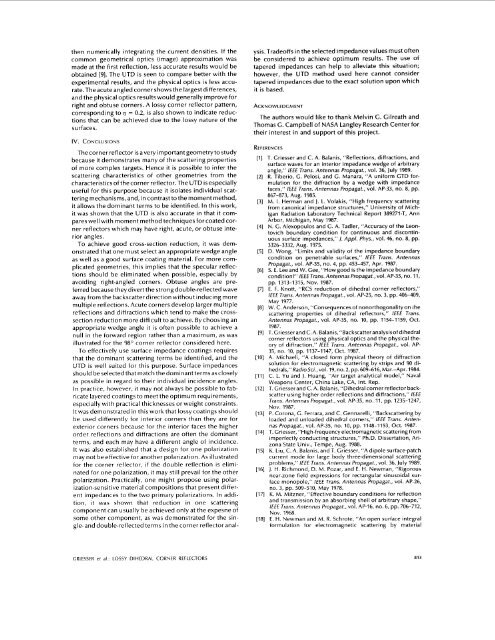





![Introduction to RF Stealth [Book Review] - Antennas and ...](https://img.yumpu.com/16857890/1/190x245/introduction-to-rf-stealth-book-review-antennas-and-.jpg?quality=85)



